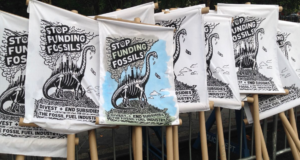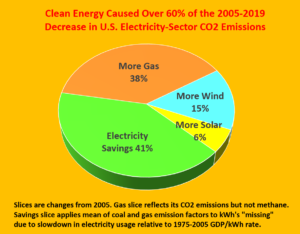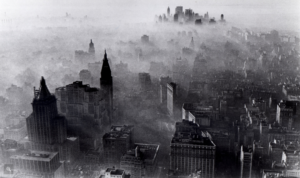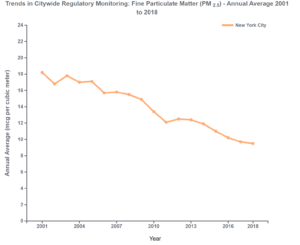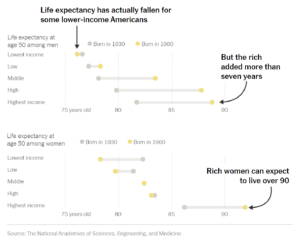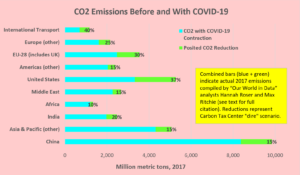Scranton, Pa. resident Kaitlin Ahern, 19, quoted in June 30 NY Times story, ‘I Can’t Focus on Abortion Access if My People Are Dying’, about younger U.S. women’s lower prioritization of abortion rights vis-a-vis other justice issues.
Is Big Carbon’s ‘Social License’ a Worthy Target?
We’re grateful to Gavin Grindon, a lecturer in art history at the University of Sussex, U.K., for his trenchant analysis last week of Big Oil’s longtime strategic sponsorships of museums and other prestigious cultural media in Britain and the United States.
In a Memorial Day New York Times op-ed, This Exhibition Was Brought to You by Guns and Big Oil, Grindon made clear that “For big oil, big pharmaceutical companies and the arms industry, sponsorship of the arts is not charity; it is a strategic expenditure.”
“To conduct their business,” he explained, “companies must build a web of influence and operation through many of the institutions that are often clustered in cities, through which they become enmeshed in our lives. London, for example, is one of the main financial centers for the oil industry. Oil companies must extract from the city a combination of services, so that elsewhere they may continue to extract, refine, transport and sell oil.”
Grindon described how this “extraction of services” works:
This is a matter not only of buying financial services from private companies, but of creating legal, political and technological leverage; facilitating clearance from regulators; gaining support from government departments or legal permission for new projects. Cultural institutions are a key part of this infrastructure into which businesses must insinuate themselves to establish an air of social legitimacy and acceptability for practices that might otherwise risk coming into question. (emphasis added)
In Britain, Grindon noted, corporate cultural insinuation typically takes the form of branded museum sponsorships which “offer businesses the attention of influential audiences, access to senior government figures at special events and the opportunity to securely intertwine themselves with ideas of national history and culture.” Whereas in the United States, cultural insinuation is more commonly conducted “through a system of boards that reward individuals who make charitable donations to the museum with the culturally influential position of trustee.”
You can’t ask for a more richly embroidered depiction of how oil and other companies “cynically use art to build webs of influence and become further enmeshed in our lives,” as the subhead of Grindon’s op-ed put it. Yet the question remains: Just how much do these webs of influence actually keep modern industrial societies locked into oil and the other fossil fuels? And the corollary: How effective, really, is deligitimizing Big Carbon — kicking fossil fuel executives off museum boards, university boards, other corporate boards, etc., “shaming” them, for short — in resetting governmental policies that enforce carbon “lock-in” against energy efficiency, renewable energy and other carbon alternatives?
Someday, social science may have the answers. For now, we’re skeptical, Grindon’s evocative essay notwithstanding.
For one thing, Big Oil is already deeply enmeshed in our lives. Every trip in a petrol-fueled car, every delivery to our doorstep from a van or truck, every airplane journey manifests and reinforces our complicity with oil. The “shame” of causing climate change isn’t limited to the fossil fuel companies, notwithstanding headline-garnering reports proclaiming that “Just 100 companies are responsible for 71 percent of global [carbon] emissions.”
Assume, moreover, that the boards of the Guggenheim, the Met, the Moma, the Whitney and the New Museum, to name five museums targeted by “protests over their links to issues like the oil and arms trade, gentrification and colonialism,” according to Grindon, were 100 percent free of fossil fuel executives. How exactly would that slow the rate of carbon emissions today, next month, a decade or now?
Yes, the legal, political and technological leverage that helps clear the paths to new oil fields and new markets, along with the regulatory clearance, governmental support and permissions, and other realms that Grindon lacked space to mention such as university R&D — would all become incrementally harder to obtain and hence more expensive to acquire. That in turn could make petroleum fuels somewhat more expensive to produce, thus hiking their prices and reducing demand. But in our estimation, these slightly higher hurdles wouldn’t materially change the infrastructural inertia and broad acquiescence that keep oil and coal and gas firmly in the saddle.
Sure, we’re all for ostracizing fossil fuel executives and others who lobby elected officials, strong-arm regulators, intimidate landowners and in some cases instigate lethal violence against protectors of nature, all to extract more petrol whose combustion products add to climate wreckage. But at what point, if ever, does this ostracism penetrate to Joe Sixpack in the showroom choosing between the F-150 that delivers 22 miles to the gallon and the F-350 that gets just 15? Or to the councilmember of a transit-rich city or suburb being pressured by NIMBY’s to reject upzoning and thus force local schoolteachers and sanitation workers to move to the auto-dependent exurban fringe? Or her counterpart in rural America or England who next week must cast the deciding vote on a wind or solar farm whose production would help phase out the gas-fired power plant three townships over?
We’ll say it again. In our view, the level of carbon emissions today and in the future is determined far more by structures of settlement, commerce and identity than by the decisions of a few hundred oil executive and business tycoons — whom we regard in any event as largely interchangeable, so long as demand renders their functions essential and profitable. And those structures, while seemingly unshakable, can be weakened and brought down with the help of carbon taxes.
Breaking Big Carbon requires huge mobilization along interconnected fronts of political action, public investment, culture change and carbon taxing. Exposing and stopping the oil industry’s cynical use of people’s longing for artistic experience is good work, and we support those doing it. But it’s not a substitute for the hard slog of politics, investment and carbon pricing. Let’s keep on with them.
Electricity Generation from Fossil Fuels Has Fallen by One-Fourth in Western Europe in 2020
Up-to-the-minute data show a 25 percent drop in electricity generation from fossil fuels this year by the five major European nations.
Combined kilowatt-hours made from burning coal, oil and gas in France, Britain, Germany, Spain and Italy totaled 209 terawatt-hours in the first five months of 2020 vs. 279 TWh in the same period a year ago, according to data aggregated by the Renewable Energy Institute from each country’s official sources and provided to the Carbon Tax Center. (A terawatt-hour equals a million megawatt-hours or a trillion watt-hours.)
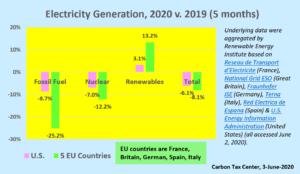
Electricity generation from fossil fuels fell 25 percent in the five largest European countries in the first five months of 2020.
Data for the United States for the same period show a lesser percentage drop, 9 percent, in electricity generation from fossil fuel plants. Nevertheless, in absolute terms the U.S. decline of 80 terawatt-hours of fossil electricity generation, from 924 TWh during Jan-May 2019 to 844 TWh in 2020, slightly exceeded the European shrinkage of 70 TWh. (The U.S. electricity sector is roughly twice as large as that of the five European countries combined, and the U.S. fossil-fuel component of electricity generation is three to four times as large as its European counterpart.)
Leading the way in Europe’s 2020 fossil-fuel power shrinkage is Germany, which until recently was widely maligned for prioritizing cuts to nuclear power rather than to its coal and lignite power generation since the 2011 Fukushima disaster. Through May of this year electricity production from fossil fuels in Germany is down by 29 TWh, a 31 percent drop from 2019. Britain followed close behind with a 17 GWh decline in fossil fuel power generation, a 30 percent cut from the prior year.
Propelling these declines are the lockdowns to contain the Coronavirus. Though the declines in road travel and aviation have received the lion’s share of attention, the EU and US data indicate that the power sector too has shrunk as economic activity has shriveled. Total electricity generation fell by 8 percent in the five European countries and 6 percent in the United States. Insofar as most lockdowns went into effect halfway through the period covered by the data, in mid-March, the figures suggest that the percentage declines in electricity since then may have been double the five-month figures, or on the order of 15 percent.
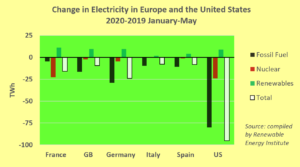
Nuclear power generation has fallen thus far in 2020 in all five countries. (The sixth, Italy, has no operating reactors.)
Curiously, nuclear power production also fell in the same period, and at a slightly greater pace than electricity generation overall: by 12 percent in the five European countries and 7 percent in the United States. (See chart at right, courtesy of the Renewable Energy Institute.) However, those declines were substantially offset by gains in renewable electricity generation, which in turn may have been abetted by what AccuWeather is calling the sunniest spring in Germany’s and England’s recorded histories.
“When demand falls, as it has during the Covid-19 pandemic due to measures taken to reduce the spreading of the virus, it is the fuel-based power generation that is economically hit,” wrote Tomas Kåberger, REI executive board chair, and Romain Zissler, senior researcher at REI, in a blog post reporting the 2020 and 2019 electricity data. “Falling demand results in lower prices in competitive markets,” they noted. And while “falling prices affect all producers’ margins, those who really suffer are the owners of power plants that have marginal costs so high that they cannot produce electricity at all,” wrote Kåberger and Zissler. “They lose all income, demonstrating the high risk of investing in fuel-based electricity generation.”
While the contractions in economic activity from the Coronavirus are expected to be transitory, the climate crisis of course is ongoing and deepening. Nevertheless, the data presented here demonstrate how the combination of electricity savings and renewable energy can leverage rapid decreases in fossil fuel-generated power and its carbon emissions.
When official GDP data are reported, it is likely that both the 25 percent drop in fossil fuel electricity in western Europe and the 9 percent decline in the United States in the first five months of the year will have exceeded the percentage decreases in economic activity. The job of western societies and governments is to expand policies to perpetuate and deepen the fossil fuel reductions during times of prosperity.
These 2020 findings mirror CTC’s analysis from last week demonstrating that during the 14-year period from 2005 to 2019, the combined effects of increased wind power, expanded solar electricity and continued growth in electricity savings accounted for the lion’s share of the enormous (one-third) drop in CO2 emissions from the United States power sector, far outpacing the contribution from replacing coal with fracked methane.
The Good News Trump Couldn’t Kill: Clean Electricity is Still Outpacing Fracked Gas in Kicking Coal to the Curb
Three and a half years ago CTC announced what we called “the good news” of the U.S. electric power sector’s rapid decarbonization. Our December 2016 blog post and its accompanying report quantified the power sector’s 25 percent reduction in carbon emissions from 2005 to 2016 and clarified what accounted for it.
That report, grandly titled “The Good News: A Clean Electricity Boom Is Why the Clean Power Plan Is Way Ahead of Schedule,” showed that while substitution of fracked gas for dirtier coal contributed to reducing emissions, a greater role was played by clean electricity: an upsurge in electricity production from renewables (wind turbines and solar photovoltaic cells), and electricity savings that caused electricity usage to flatten even as economic output increased.
Today, in an updated version of that report, we extend those findings with new data through 2019, and the results are impressive and satisfying.
We find that in 2019 U.S. electricity sector emissions of carbon dioxide were 33 percent below 2005 levels, thus surpassing, eleven years ahead of schedule, the Obama Administration’s Clean Power Plan goal of a 32 percent cut in electricity-generation carbon emissions from 2005 to 2030. We estimate that 62 percent of the electricity sector’s carbon reduction since 2005 has been due to clean electricity, with the other 38 percent due to substitution for coal by natural gas.
This finding depends critically on the fact that from 2005 to 2019, total U.S. generation of electricity rose by a mere 2.4 percent — equivalent to an annual average growth rate of just 0.17 percent — even as the U.S. economy, measured imperfectly yet officially by Gross Domestic Product, expanded by nearly 28 percent. The majority contribution to electricity decarbonization of clean electricity belies the prevailing narrative crediting fracked gas for the lion’s share of the reduction in coal burning and the resulting lowering of carbon emissions.
Our new report, “The Good News Trump Couldn’t Kill: The Clean Electricity Boom Is Doing More Than Fracking To Decarbonize America’s Power Sector” (download as pdf), also finds that the burning of coal to make electricity in the U.S. shrank at a faster clip during the Trump administration (2019 vs. 2016) than over the course of the Obama administration (2016 vs. 2008). The respective annual decline rates in tons per year were 47,600 (Trump) and 46,300 (Obama); expressed as percentages, the respective annual decline rates were 7.4 percent per year (Trump) and 5.2 percent (Obama). (The average percentage difference between the Trump and Obama years is greater than the tonnage difference because of the Trump years’ lower baseline level.)
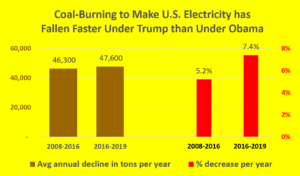 The free fall in use of coal to make electricity has been widely reported. The role of electricity saving has not. This is partly due to the difficulties of quantifying electricity savings and of booking those savings as reductions in uses of particular fuels. (Our solutions are to calculate the savings relative to hypothetical electricity generation if the 1975-2005 relationship between electricity growth and economic growth had continued; and to assign half of the reduced kilowatt-hours to coal and the other half to natural gas.)
The free fall in use of coal to make electricity has been widely reported. The role of electricity saving has not. This is partly due to the difficulties of quantifying electricity savings and of booking those savings as reductions in uses of particular fuels. (Our solutions are to calculate the savings relative to hypothetical electricity generation if the 1975-2005 relationship between electricity growth and economic growth had continued; and to assign half of the reduced kilowatt-hours to coal and the other half to natural gas.)
But the failure to give electricity saving its due runs deeper. The penetration of energy-saving digital technologies in energy management, product design and manufacturing isn’t an eye-catching subject. Neither is the emergence of a business sector that finds, finances and delivers money-saving efficiency improvements in commercial and apartment buildings. Nevertheless, both phenomena are widespread and robust. So are ratepayer-funded energy-efficiency programs mandated by state public utility commissions, often with the insistence (and guidance) of tenacious and knowledgeable environmental groups.
Nevertheless, the flattening of U.S. electric usage and generation from the 7% annual growth rates that prevailed for most of the first three-quarters of the 20th century, down to 2.5% average growth from 1975 to 2005, and to just 0.2% per year annual growth from 2005 to 2019, is a profound development warranting much greater attention — if not in mainstream journalism then at least in energy and climate reporting. We hope that publication of this updated “Good News” report will help spur this notice.
In one of the stupidest statements in history, Trump just said ‘if we didn’t do any testing, we’d have very few cases’ of the pandemic coronavirus. Thus introducing the Republican solution to #climatechange: just stop reading the thermometers.”
Peter Gleick (co-founder, Pacific Institute; MacArthur “genius award” recipient; member, National Academy of Sciences), via Twitter, May 15.
It’s Earth Day — Let’s Celebrate New York City’s Cleaner Air
I posted this on Streetsblog yesterday, April 22, the 50th anniversary of Earth Day. It’s NYC-centric and doesn’t mention climate change (!). But its lessons apply nationwide, and good news is always welcome, especially now. PS, there is Covid-19 content, toward the end. — CK.
On Thanksgiving Day in 1966, I was driving from my parents’ home in suburban Long Beach, NY to dinner with family friends in Forest Hills, Queens. The air seemed extra bad. My eyes were teary, my nostrils were twitching and the radio was reporting some sort of pollution episode.
At that very moment, New York Times photographer Neal Boenzi was memorializing what the air looked like from a perch high up in the Empire State Building: smog shrouding skyscrapers like Met Life, NY Life and the Flatiron Building; smoke obscuring the financial district; the Hudson and East Rivers, invisible.
Fast forward 50 years to a mid-September weekday in 2016. Former New York City government official and activist Jon Orcutt steps onto the India Street Pier in Greenpoint, Brooklyn and aims his iPhone at east Midtown. The contrast of his photo with Boenzi’s couldn’t be more stark, and not because one was black and white while the other was color and digital. Ocutt’s picture glistens with mountaintop clarity. Zoom in, and every building — every window — is distinguishable. Billowing clouds adorn the sky, multitudes of pristine blue and pellucid white.
The distance between the photos attests to the past half-century’s clean-air revolution — a vast do-over to our nation’s skies, much of it led by New York City. Through citizen activism, enlightened governance and innovative technology, pollution levels were slashed across the board. No one knows the precise extent, but my best guess is that from the late sixties to today, citywide levels of noxious pollutants like PM2.5 (tiny particulates that invade and obstruct the lungs) and photochemical smog (a gaseous soup cooked by sunlight from nitrogen oxides and volatile organic compounds) fell by over 80 percent. Another lethal pollutant, sulfur dioxide, almost certainly declined even more. (The writer-activist Bill McKibben reported this week in his weekly New Yorker magazine climate newsletter that “air pollution has dropped by more than sixty per cent across America since 1970.”)
These improvements didn’t just enhance public health and cut medical costs. They also contributed to New York City’s economic resurgence. Here, too, no one knows precisely how much; polls don’t ask if cleaner air factored into people’s decisions to settle here. But my guess is that, after reduced street crime, cleaner air has been on a par with better schools and improved public transportation in attracting and retaining residents and businesses to New York.
No single regulation or program or anti-pollution device wrought these striking gains. Rather, a multiplicity of initiatives reduced air pollution levels here. These have probably been key:
- Lowering five- to 10-fold the sulfur content of fuel oil burned for heating and power generation*
- Tailpipe and engine technologies that cut per-mile auto emissions at least 10-fold
- Cleaner fuels and engines for diesel-powered heavy vehicles (still a work in progress)
- Investments in mass transit that stanched growth in auto travel (partly undermined by Uber)
- Widespread switching of dirtier oil-fired power, furnaces and boilers to natural gas
- Decommissioning in-building incinerators
- Controls on emissions from upwind sources such as refineries and power plants
* = CTC readers will enjoy my 2009 post in Grist relating how NYC’s 1972 emergency surcharge on dirty oil — an early instance of Pigovian taxation — protected the city’s low-sulfur oil regulation from oil industry interference.
These developments didn’t happen by themselves. They were, and are, the most visible and impactful fruits of the environmental movement whose arrival 50 years ago as a political and cultural force we mark on Earth Day today. At its forefront were the Natural Resources Defense Council and NYC-based organizations such as Citizens for Clean Air (which preceded Earth Day), Straphangers Campaign and Transportation Alternatives (which came in its wake); indefatigable campaigners like Gene Russianoff, Marcy Benstock, Rich Kassel and the late Carolyn Konheim; and proactive city officials like Mayor John Lindsay, his Environment Commissioner Jerry Kretchmer, and engineering dynamo Brian Ketcham. In turn, these individuals and institutions were backed by (and often preceded and helped spark) federal environmental legislation enacted in the national upwelling of environmental activism that took full flower in the early 1970s.
It is true, and shameful, that, nationwide, communities of color today breathe dirtier air than wealthy, white areas (though in New York City there is surprising overlap between affluence and pollution). Even so, air quality has risen significantly in most environmental justice communities in recent decades, with more gains likely as ecological activism grows increasingly black- and brown-led, although that, of course, depends heavily on the outcome of the next election.
I have labored in recent years to foster appreciation of air quality progress, especially in New York City. Valorizing environmental regulations and, at least implicitly, the scientists, attorneys and activists whose labors and expertise brought them into being, isn’t just right, it’s an investment in protecting and enhancing our environment going forward.
Well, my project has a ways to go. Case in point: this statement in a recent New York Times story on a preliminary Harvard School of Public Health study linking higher levels of PM2.5 pollution with increased COVID-19 deaths:
If Manhattan had lowered its average particulate matter level by just a single unit, or one microgram per cubic meter [µg/m3], over the past 20 years, there would have been 248 fewer COVID-19 deaths in Manhattan by that point in the outbreak [April 5].
That framing is completely backwards, in my view. Rather than bemoaning the failure to reduce New York pollution levels by one hypothetical unit, we should be celebrating the reductions already accomplished. They are enormous: almost certainly more than 20 µg/m3 since 1970 (early baseline data for New York and other cities is sketchy). If the preliminary link between particulate pollution and COVID-19 mortality in the Harvard study is confirmed, then NYC’s pollution reduction since the time of Earth Day will be shown to have spared vast numbers of lives through population-level improved lung functioning.
(The linkage between polluted air and COVID-19 mortality is this, in a nutshell: the coronavirus kills primarily by ravaging people’s lungs, while chronic exposure to fine particulate matter and other air pollutants degrades lung functioning, rendering inhabitants of polluted areas more vulnerable once they’ve been infected. Conversely, the advent of cleaner air has given New Yorkers a hidden but sizable degree of immunity, relative to our susceptibility if the air had remained chronically polluted.)
It’s tempting to recast the pull-quote from the Times in terms of thousands of New York City COVID-19 deaths already averted, but I’m going to demur. For one thing, the hypothetical 248-lives figure there (which the Times article took directly from the preliminary Harvard paper) was calculated from a baseline of citywide deaths and ascribed (incorrectly) to Manhattan alone. More importantly, I’m not convinced that the correlation between PM2.5 pollution and COVID-19 mortality is as strong as the paper contends. Despite laudable effort by the authors, their county-level analysis may not have been fine-tuned enough to fully control for the 17 different possible confounding factors they included in their model such as population density and education levels.
Consider that from 2001 to 2017, a period rigorously analyzed by environmental-health experts at NYC’s Department of Health, citywide average PM2.5 levels declined from around 18 µg/m3 to around 10 (see graph). That’s a drop of 8 µg/m3 in just 16 years. If we extend that rate of improvement backwards to the three decades leading to 2001 — when many of the innovations I bulleted earlier were taking effect — the drop in PM2.5 in that period would be around 16 µg/m3. That would yield an overall reduction of 24 µg/m3 in fine particulate pollution levels from Earth Day to today.
But today, let’s lift our gaze from COVID-19 and epidemiology to New York’s clearer skies. Dear reader, please join me in toasting a half-century of scientist and activist vision and grit that has made — and continues to make — our city cleaner, healthier and more beautiful.
CO2 emissions will shrink this year. How much?
Note: We’ve revised this post to reflect an April 15 update from Carbon Brief in which it raised its CO2 reduction projections for 2020. More details appear at end of post. — C.K., April 29.
A new post this week from Carbon Brief’s Dr. Simon Evans, Coronavirus set to cause largest ever annual fall in CO2 emissions, projects a 5-6 percent fall this year in worldwide emissions of carbon dioxide from last year’s level on account of the coronavirus.
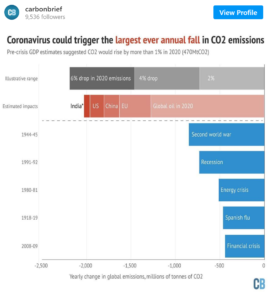
Courtesy, Carbon Brief. Geographical estimates exclude oil since that is subsumed in “Global oil in 2020” figure. Link in opening paragraph leads to CB post which has full graph notes and sources. Note that “tonne” unit is metric ton, or thousand kilograms.
Dr. Evans is highly regarded for his analyses of global energy trends, and his new post does not disappoint. His projections, shown at left, draw on what he calls “five key datasets and projections covering roughly three-quarters of the world’s annual CO2 emissions, including the entire output of China and the US, the EU carbon market, the Indian power sector and the global oil sector.” Those sectors’ projected reductions, shown in the rust-red bar near the top, sum to around 2,000 million metric tons, equivalent to 5.5 percent of the 2019 worldwide total.
The five trailing blue bars in the Carbon Brief graphic underscore the prospective downturn’s unprecedented extent. They denote actual reductions during traumatic world events, from the 1919 Spanish flu pandemic and the 1945 close of World War II to the 2009 financial crisis, which shows the smallest emissions drop. Using tons of decline as the metric — after all, the climate system responds to tonnages of CO2, not percentage changes — none of the earlier five contractions rivals Carbon Brief’s projected 2020 downturn. The closest is the 845 million tonne reduction in 1945, caused not just by the collapse of economic activity in defeated Germany and Japan but also by the battered economies of victor states such as the Soviet Union and the United Kingdom.
Last month, we at Carbon Tax Center published a post estimating that global emissions this year could plunge by as much as 7,640 million metric tons from their business-as-usual level. That would be nearly four times as great a reduction as the 2,000 million tonne drop in Dr. Evans’ Carbon Brief post, a huge gap but one largely explainable by these differences between our respective approaches:
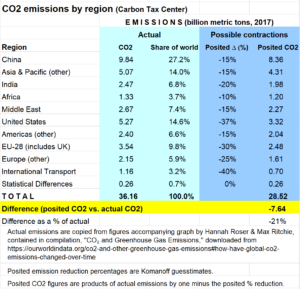
CTC’s “dire case” projections of CO2 declines by sector are copied from our March 24 post, Could COVID-caused economic cratering trim 1 ppm from atmospheric CO2?
- Carbon Tax Center’s figures are in Btu’s, a good but imperfect proxy for carbon emissions, whereas Carbon Brief employs CO2 directly.
- CB’s calculations omit sectors outside of its “top five,” which account for 24% of worldwide carbon emissions.
- CB conservatively applies its estimated reductions to a 2020 baseline that would have exceeded 2019 emissions by 1,000 million tonnes, effectively handicapping its 2020 reductions.
- CB chose to base its top five sector reductions on official, and necessarily conservative, sources such as the U.S. EIA, the IEA, and CB’s own mid-Feb. analysis of China’s CO2 reductions.
- CTC took a deliberately aggressive approach to estimating reductions in order to stake out an outer limit.
We add this sober warning from Dr. Evans’ post:
To put the potential 2020 coronavirus effect in a broader climate context, it is worth adding that global emissions would need to fall by more than 6% every year this decade – more than 2,200MtCO2 – in order to limit warming to less than 1.5C above pre-industrial temperatures. (This figure is based on the 2018 Intergovernmental Panel on Climate Change (IPCC) special report, which found that global emissions in 2030 needed to be 45% below 2010 levels, in order to limit warming to 1.5C.)
It should go without saying that the forced nature of the 2020 emissions contraction disqualifies it as a model for going forward. Nevertheless, surpassing, even under great duress, and even for just one year, the recurring 2,200 million tonne per year contraction cited as essential by Carbon Brief, is not to be sneezed at.
A useful way to think about CTC’s “extreme” 7,600 million tonne estimate is that it would buy the world three to four years worth of the 2,200 Mt reduction otherwise needed each year to the next … and that in 2023 or 2024 worldwide emissions would need to fall, from the reduced level, by 2,200 million tonnes each year, to get onto the IPCC trajectory for keeping warming to less than 1.5C.
Point being: while Covid-19 is not how the world should have started down the road to reducing emissions, it has gotten our attention and is, at least, a start.
Carbon Brief’s April 15 amendment to its original April 9 post (linked to at the top of our post) reads: Update 15 April 2020: This analysis was updated in light of new forecasts for global oil demand in 2020, which suggest a significantly larger drop this year. The original version had put the potential impact of coronavirus at 1,600MtCO2 in 2020, equivalent to 4% of 2019 emissions.
NY Times Depicts Inequality’s Costs in Dollars and Lives
A post today by New York Times economics columnist David Leonhardt, America Will Struggle After Coronavirus. These Charts Show Why., casts U.S. economic inequality in especially stark terms. Below, we reproduce the post’s most vivid graphs and striking prose.
Why highlight rampant economic inequality in America? Because we at Carbon Tax Center are convinced that U.S. political action to arrest climate change will remain largely stillborn so long as economic insecurity is rampant.
As I wrote earlier this month in a post co-authored with Christopher Ketcham for The Intercept:
People whose health is tenuous and whose pocketbook is empty can’t easily stand up for climate action, but they may do so if government has put them on a solid footing and, in the Green New Deal, provided a framework for paying them good wages to actually implement it.
Moreover, funding for the Green New Deal can and should come from America’s super-rich. “The past decade’s research and agitation on economic inequality must culminate,” we wrote,” in transmuting extreme private wealth into a new collectively shared wealth of renewable energy and sustainable communities.”
Of late, Leonhardt of The Times — a climate hawk and, until recently, carbon tax supporter before the politics of stand-alone carbon taxing became fraught — has written extensively on economic inequality and its dire consequences for Americans. Except where noted, all of the text below has been excerpted from his post that we linked to at the top.
1. Incomes have stagnated. But not for the rich.
 One way to think about the rise in inequality is to imagine how different the economy would be if inequality hadn’t soared over the past 40 to 50 years. In that scenario, with the same G.D.P. that we have today but with 1980 levels of inequality, every American household in the bottom 90 percent of income would be earning about $12,000 more — not just this year, but permanently. In effect, each household in this bottom 90 percent is sending a check for $12,000 to every household in the top 1 percent, year after year after year.
One way to think about the rise in inequality is to imagine how different the economy would be if inequality hadn’t soared over the past 40 to 50 years. In that scenario, with the same G.D.P. that we have today but with 1980 levels of inequality, every American household in the bottom 90 percent of income would be earning about $12,000 more — not just this year, but permanently. In effect, each household in this bottom 90 percent is sending a check for $12,000 to every household in the top 1 percent, year after year after year.
2. Whose net worth increased the most? The rich.
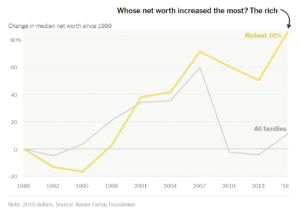 The trends on wealth are, if anything, more stark. In 2016 the median American household had a 30 percent lower net worth than the median household in 2007. How could this be, given the bull market during much of that period? The answer is that most Americans own little or no stock. Their main asset is their home. The affluent, of course, do tend to own stock, and the median net worth of the richest 10 percent of households rose 13 percent from 2007 to 2016 (the last year for which the Fed has released data).
The trends on wealth are, if anything, more stark. In 2016 the median American household had a 30 percent lower net worth than the median household in 2007. How could this be, given the bull market during much of that period? The answer is that most Americans own little or no stock. Their main asset is their home. The affluent, of course, do tend to own stock, and the median net worth of the richest 10 percent of households rose 13 percent from 2007 to 2016 (the last year for which the Fed has released data).
3. The richer live longer than the rest of us
The trends in health and life expectancy are also deeply worrisome. Rich and poor Americans used to have fairly similar lifespans. Now, however, Americans in the bottom fourth of the income distribution die about 13 years younger on average than those in the top fourth. No other rich country has suffered such slow growth in life expectancy. In 1980, Americans lived roughly as long as the British and French did. Not anymore.
[Back to CTC]
These are highlights of Leonhardt’s post. Much of it — not excerpted here — concerns equally weighty matters like racial income and wealth disparities, the widening life-expectancy gap between the U.S. and other rich nations, our “uniquely expensive and inefficient medical system,” and the tripling since the early 1990s in rates of “deaths of despair” — from suicide, alcoholism and drug abuse — among American adults (ages 25 to 64) without a four-year college degree. (April 14 addendum: The Times today published an opinion piece by economists Anne Case and Angus Deaton, authors of “Deaths of Despair and the Future of Capitalism,” arguing that Americas unfettered for-profit health-care system “takes from the poor and working class to generate wealth for the already wealthy.”)
And more: the chronic-pain gap and one-parent family gap between families on either side of the class divide; the decline of labor unions that formerly gave non-college workers social solidarity as well as economic strength; and of course differences between labor participation (a more accurate and telling metric than unemployment rates, which don’t reflect would-be workers who have dropped out of the workforce).
Leonhardt’s article conludes:
Given all of this, it makes sense that so many Americans have soured on their own country. For almost 20 years, through economic booms and busts and through presidencies of both parties, most Americans have said the country was headed in the wrong direction. They’re right about that.
To repeat: CTC began bringing America’s stark inequality to the fore late last year, in this brief account and this longer narrative, from two convictions: that wealth taxes must be the primary means to pay for the Green New Deal, and that support for concerted climate action depends on making Americans more secure and making America more just.
The work continues.
Note: Leonhardt’s July 3 follow-on post, The U.S. Is Lagging Behind Many Rich Countries. These Charts Show Why., adds to this rich vein with trenchant comparisons of U.S. with western Europe on union membership, minimum wage rates, life expectancy, health care costs, etc.
Can This Pandemic Spur Climate Action?
[NB: This post is co-authored with Christopher Ketcham. A slightly different version was published earlier today in The Intercept under the headline “What The Coronavirus Pandemic Can Teach Us About The Climate Emergency.”]
Greta Thunberg couldn’t do it. Bill McKibben and 350.org couldn’t do it, and neither could the Paris climate accord. But Covid-19 is cutting human-caused emissions of carbon dioxide and other greenhouse gases as travel and other economic activity in much of the world slow or halt altogether.
While the contraction in CO2 emissions set off by the virus may not be as pronounced as the related though distinct fall in “conventional” pollutants like soot and smog, it is far more consequential. Soot and smog poison and kill only in the present, while greenhouse gases stick around to maim the climate for the next century. Burning a fossil fuel today is tantamount to signing a death warrant for future generations. Conversely, forgoing an action that would have caused a fossil fuel to be burned creates a permanent benefit.

Traffic is unusually light in Oakland, Calif., on the approach to the Bay Bridge on March 17, 2020, after seven Bay Area counties are locked down in an unprecedented shelter-in-place order. Photo: Jane Tyska/Digital First Media/East Bay Times via Getty Images. (Originally published in The Intercept’s April 4 version of this post.)
Until now, the only downturn of note in total worldwide CO2 emissions during the era of climate awareness — defined as the period beginning in 1995 with the first U.N. Climate Change Conference — was in 2009, the onset of the Great Recession. That downturn was brief and mild.
In contrast, the current contraction could be severe enough to cut in half this year’s addition to the atmosphere’s carbon dioxide concentration — the metric that dictates climate change — according to calculations by co-author Charles Komanoff for the Carbon Tax Center.
Is it cruel to point approvingly to the steep reduction in carbon emissions now unfolding, given the skyrocketing deaths, lost livelihoods, and widespread privation? And won’t the reductions be negated as the virus is tamed and emissions come roaring back? No and no.
Like so much else, whether or not the current reduction in CO2 is sustained will depend on who gets to reconstruct society after the virus. But the reduction will not be negated. Just as carbon emissions persist long enough in Earth’s upper atmosphere to act as permanent climate change agents in terms of one individual’s lifetime, avoided emissions are a permanent balm.
The airplane trips you won’t take this year won’t be made up in 2021, for the simple reason that most people who use airplanes do so regularly. A missed trip isn’t a once-in-a-lifetime experience that will be put back next year; it’s a missed trip, period. Ditto for work commutes and leisure activities.
So yes, the precipitous drop in burning petrol for vehicles and aircraft has a lasting imprint. The contraction of the U.S. economy this year could purge 30 to 40 percent of carbon emissions we would otherwise spew. Similar but milder jettisoning of carbon-burning in the rest of the world could collectively trim up to one part per million from the atmosphere’s present 415 ppm concentration of CO2 — a modest climate-protective achievement, to be sure, but one without precedent in the modern era.
The suffering is a different story. Were a happiness/misery calculator able to quantify the pluses and minuses to well-being from events befalling human society, the coronavirus’s flattening of the rising CO2-in-the-atmosphere curve would obviously be swamped by the lost life and the disordering of business as usual.
And yet business as usual must come to an end if we are to hand down a livable planet to our children.
The rub is how to slash carbon emissions with minimum suffering and maximum social and economic justice, and without nature forcing the reductions on us via pandemics or other chaotic black swan events that are surely in store.
The fact that human behavior and activity are undergoing climate-beneficial changes in the crucible of Covid-19 suggests that “business as usual” can be altered, and quickly. Though we can’t yet point to new models of planned and equitable carbon reduction, there are four identifiable pandemic-driven upheavals of social consciousness that should give us hope of instituting the transformations necessary for civilization not to commit collective climate suicide.
One is that science’s prestige and value are being restored. Americans watching Trump’s circus-like coronavirus daily briefings see National Institutes of Health immunologist Dr. Anthony Fauci stepping in to correct the president’s dangerously ignorant commentary. Similarly, we know it is the community of front-line doctors, nurses, and health care workers who will care for the sick; the epidemiologists and science journalists who will inform the public’s response; and trained chemists, biologists, and statisticians who will synthesize and prove the vaccines that will bring the pandemic to an end. As environmental legal scholar Michael Gerrard wrote last week, the climate change lessons of Covid-19 are to heed the warnings of scientists, do everything possible to minimize the hazards they predict, and prepare to cope with the impacts that remain.
Second, the crisis is helping us see just how much our well-being depends on muscular, proactive governance. Government of the people and for the people is literally the thing that’s now needed more than ever. The people must be sovereign over corporations and not vice versa — a point driven home by the tepid response of big business to Trump’s exhortations to step up manufacture of equipment to protect health care workers.
Third, we may be shaking loose the defeatism that nothing can be done quickly. Take the example of those of us sheltering in place: We are learning, overnight, that simplicity isn’t necessarily austerity, frugality need not be privation, and that we can forgo quite a lot of our leisure and consumer entitlements if it serves some higher purpose — at present, to stop the sickening and death of our fellow human beings; in the longer run, to bend the rising curve of carbon emissions and put a hard stop on climate chaos.
Moreover, if our society can act, finally, to manufacture a million ventilators and a billion protective masks, surely we can within a few years act on a far grander scale to erect, say, a million wind turbines, insulate and solarize a hundred million buildings, carve ribbons of bicycle paths throughout our cities and suburbs, and so on. With the pandemic enforcing a brutal but necessary reset, the NIMBYism that has impeded this kind of progress practically everywhere might be swept into the dustbin for good.

Volunteers for nonprofit organization Martha’s Table load bags of fresh produce to distribute to people in underserved communities on April 1, 2020, amidst the coronavirus pandemic in Washington, D.C. Photo: Chip Somodevilla/Getty Images. (Originally published in The Intercept’s April 4 version of this post.)
Most hearteningly, the crisis is instilling a renewed appreciation of social solidarity. The more we are forced to quarantine and isolate, paradoxically, the more we become cognizant of the need for mutuality and social relations and social conscience. As New York Times columnist Roger Cohen wrote yesterday, “If this plague that cares not a whit for the class or status of its victims cannot teach solidarity over individualistic excess, nothing will.”
My well-being depends on your not being sick. My ability to be fed depends on your ability to grow and transport and distribute food. My life is now literally in your hands, as you make decisions whether to restrain your activity in the public sphere, keep your distance, self-quarantine.
If we so fully need each other, how can I abide your not having affordable health care? In this moment when the precarity of half or more of American households is laid bare, how can I abide a government that places the well-being of billionaires — whose wealth each week generates more money than many of us earn in a lifetime — above that of the 90 percent of Americans who make less than $100,000 a year?
What does solidarity have to do with climate? Everything. People whose health is tenuous and whose pocketbook is empty can’t easily stand up for climate action, but they may do so if government has put them on a solid footing and, in the Green New Deal, provided a framework for paying them good wages to actually implement it.
Synergies abound. With the U.S. government providing direct payments to American households, it’s only a step or two to paying coal miners and cattle ranchers to become solar installers and wind farm maintainers. Enacting some form of guaranteed income, even just temporarily, could pave the way for the “carbon fee and dividend” approach to taxing carbon fuels without further burdening the less well-off. In a different vein, trading frenetic foreign travel for staycations could downsize socially destructive companies like Airbnb, making rental apartments more affordable and in turn diminishing long-distance commuting and slashing carbon footprints.

Table shows assumptions supporting Carbon Tax Center assertion that pandemic-caused economic disruptions could shave 1 ppm from atmospheric CO2. See linked CTC post for full discussion.
As for the super-rich, never have their fortunes been so fully revealed as hollow and corrosive. Worldwide, the wealthiest 5 percent of households collectively burn more carbon than the entire bottom half, according to a comprehensive new report from the University of Leeds. Could the past decade’s research and agitation on economic inequality now culminate, in the pandemic’s wake, in an insistence on transmuting extreme private wealth into a new collectively shared wealth of renewable energy and sustainable communities?
Table presents the calculations and assumptions underlying Carbon Tax Center’s assertion that economic disruption from the pandemic could cut 1 ppm from atmospheric CO2. For fuller discussion, follow link from “calculations” higher up in the text.This, more than fossil fuel divestment or class-action litigation, is the kind of program that will actually cast off the yoke of the fossil fuel empire upon which the portfolios of the super-rich depend. In the process, the toxic aspiration to join the super-rich could be swept aside. Bye-bye, lusting after commuter helicopters. Bye-bye, hungering for one’s own island. Bye-bye, legislatures purchased by dark money.
As for those in the rarified upper classes who, in Margaret Thatcher’s iconic phrasing, embrace the libertarian right-wing precept that “there is no such thing as society,” let’s hope they will be answered by the millions of commoners who see clearly, as the pandemic rages, that we are all in this leaky boat together.
Charles Komanoff, a New York City-based economist and activist, directs the Carbon Tax Center. Christopher Ketcham, an upstate New Yorker, is author of “This Land: How Cowboys, Capitalism, and Corruption are Ruining the American West.”
Could COVID-caused economic cratering trim 1 ppm from atmospheric CO2?
Calculations by the Carbon Tax Center suggest that the worldwide economic contraction from steps being taken to slow the spread of deadly COVID-19 could halve this year’s rise in the atmosphere’s carbon dioxide concentration.
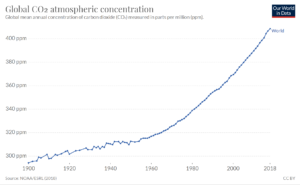
The last time average atmospheric CO2 rose less than 1 ppm was 1993. Could 2020 do likewise? (Graph is from “Our World in Data” website mentioned and linked to below.)
This finding is largely illustrative and encased in caveats. First, the average CO2 level wouldn’t actually fall; rather the business-as-usual annual rise of around two ppm would be trimmed to just one. And for that to happen, the slowdowns in travel, industrial production, goods movement and commercial activity, and the accompanying reductions in use of fossil fuels and carbon emissions, would have to be steep and prolonged, as our calculations show below.
The most critical caveat, of course, is the widespread deaths and massive dislocations bound up with these events. Megadeaths and cataclysmic job losses are not anyone’s preferred path for slowing climate change. Nevertheless, the calculations provided here may be instructive.
U.S. Reductions
Federal bean-counters divide U.S. energy use into four categories: Industrial, Transportation, Commercial, Residential. We assume that the first three contract by 50 percent as factory production tumbles, aviation evaporates, commuting recedes, recreational travel dissipates, and offices, stores and performance spaces remain empty. (April 2 addendum: U.S. gasoline demand for the week ending March 27, before the economy fully shut down in all 50 states, was 27 percent less than in the same year-earlier week, according to Energy Information Administration data.) We assume that residential energy use, which currently is around a fifth of the total, rises by 10 percent due to enforced home-stays.
These assumptions add up to a 37 percent shrinkage in U.S. energy use measured in Btu’s. The fall in carbon emissions might be a bit greater since carbon-free energy sources — nuclear power, wind turbines and solar panels — would keep humming while dirtier coal and petroleum bore the brunt of the cutbacks. We’ll watch to see how other modelers handle the complex calculations.
Rest of World
U.S. carbon emissions now (2017) account for only 15 percent of the world’s total. To baseline the rest of the world’s CO2 we turn to the superb data compilations and visualizations assembled under the aegis of “Our World in Data.” Analysts Hannah Roser and Max Ritchie divide the globe into nine regions, plus International Transport (largely long-distance shipping and aviation).
We assigned various percentage reductions to each region as shown in the graph at right, starting with our U.S. figure of 37% derived above. Other reductions range from highs of 40% (International Transport) and 30% (European Union) to lows of 10% (Africa) and 15% (most of Asia; also Latin America). The worldwide average — again, this is speculative calculating — is 21%.
We again stress that these are guesses and are skewed to the high side; as dire as things are, it still seems unlikely that fossil-fuel burning and consequent carbon emissions will fall this steeply. Moreover, deep contractions probably won’t be sustained for a full year.
Translating CO2 emissions to CO2 levels
The numbers are largely illustrative and we’ve pushed them hard. Summing the reductions shown in the graph, they imply that 2020 emissions conceivably could fall short of the 2017 baseline or “default” value by 7 to 8 billion metric tons (gigatonnes).
The redoubtable “Skeptical Science” brief, Comparing CO2 emissions to CO2 levels, tells us that each 7.8 gigatonnes of emitted carbon dioxide adds 1 part per million to atmospheric concentrations of CO2. Equivalently, reducing emissions by 7-8 gigatonnes — whether absolutely or relative to a baseline trajectory — averts a 1 ppm rise in atmospheric CO2.
Keep in mind that this would constitute a permanent drop. Atmospheric concentrations of CO2 would be 1 part per million less than otherwise not only at the end of 2020 but at the end of 2021, 2022 and every year going forward. The boon to climate and humanity, though slight (considering that the world has overshot the postulated 350 ppm maximum safe level by more than 50 ppm), would be indelible.
We hope in future posts to explore how much of the current reduction in CO2 might be negated by economic “bounceback” (short answer: not much); and, more importantly, how the economic and social upheavals from the coronavirus crisis might open up political pathways leading to decisive, longer-term action to bring down carbon emissions without widespread suffering.
Addendum, April 11: See our new post today, CO2 emissions will shrink this year. How much?, for a discussion of parallel but different projections of worldwide 2020 CO2 contractions from Carbon Brief.
- « Previous Page
- 1
- …
- 12
- 13
- 14
- 15
- 16
- …
- 170
- Next Page »


